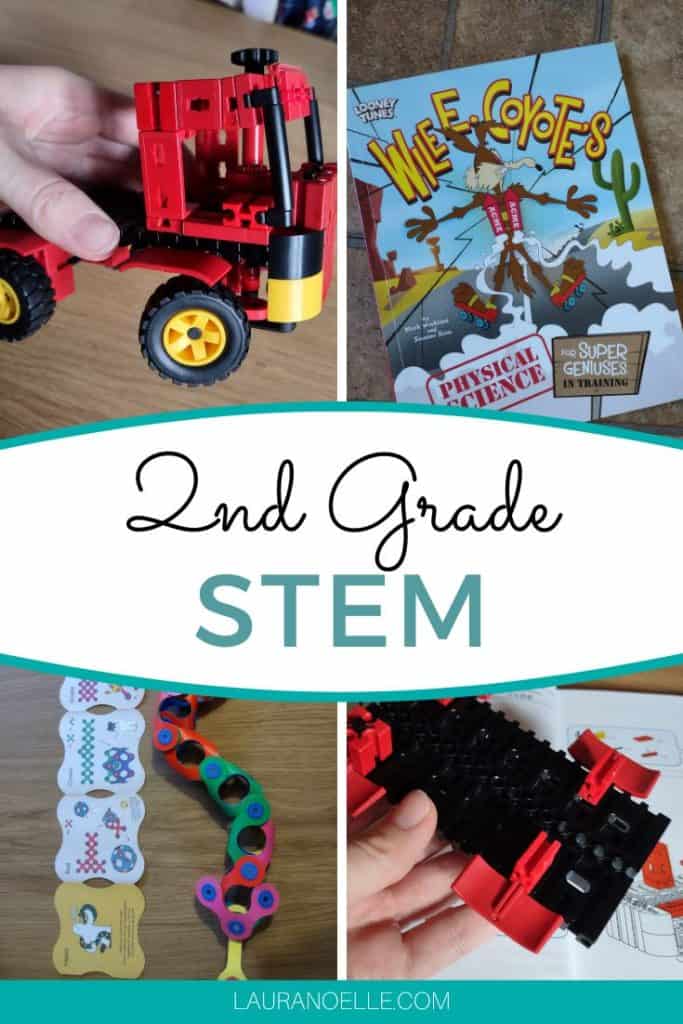STEM in 2nd Grade || Timberdoodle Curriculum Kit Review
This post may contain affiliate links, which means I may receive compensation if you make a purchase using one of these links.
The hands-on aspect of Timberdoodle kits is what drew me in years ago. Here’s what we thought of the 2nd-grade STEM materials.

There are so many reasons why building, engineering, and working with their hands are crucial to brain development and learning. It should absolutely be a pillar of every child’s education, whether they are “gifted” at it or not.
In the 2nd Grade Curriculum Kit, Timberdoodle offers three components for STEM–two building/creating kits and one book all about the foundations of physical science in a fun presentation.
A special thanks to Timberdoodle Co. for sponsoring this series by providing us with a complimentary 2nd Grade Curriculum Kit. All opinions are our own!

Fischertechnik Universal 4
If your child is enamored by engineering, and building models, and wants an authentic look and feel, Fischertechnik is for you. This European construction kit is the real deal and the pieces mimic mechanical engineering with realistic shape and precision.

The instruction manual is filled with step-by-step pictures of the models. Fair warning, the pictures of the pieces are very small and you might have to pick up the manual and squint at it a bit to decipher what you’re looking at. (Or maybe that’s just me!)

With 500 pieces that create up to 40 different models, they are tiny and not very easy to distinguish to the untrained eye. My 7-year-old daughter was not able to find the correct pieces on her own. This was not a surprise to me though as she has always struggled a bit with putting together models.

She has always excelled in the more creative expression of building things with her own flair, but with this kit, you need to have a basic understanding of mechanics first: gears, crank handles, belt drives, and cable winches. Let’s be honest…I’m not all that familiar with those things myself!

I do appreciate that each pictured step only used a few different pieces, so it doesn’t feel too overwhelming, even if you have no idea what you’re looking at. (Again, a disclaimer that I’m a mechanical novice!). When you’re putting together individual pieces, most of them slide together fairly easily, but as you build your model, some of them are quite snug and my daughter needed my help to attach them.
This is of course a good thing when it comes to the finished model staying together when they play with it, but it also means that taking a model apart is going to take some finger strength!

When we finally did finish a model, it was quite impressive. Moving wheels and mechanical parts made my daughter “ooh” and “ahh”, which I hope will spark her interest in continuing to complete the models, even when she finds them difficult.

I currently store our pieces in little bins in a small plastic drawer, but they have to be dumped out all over the table when we make a model in order to find the correct pieces. In the future, I think I’d like to invest in a bead organizer or tackle box-type storage system where all the different kinds of small pieces could be grouped together. This would make the building process go so much faster and ease everyone’s frustration with the teeny tiny pieces.

Overall, Fischertechnik is a fantastic STEM kit, but be prepared to have your kiddo grow into it if they aren’t already mechanically inclined!

Clixo Create
With flexible magnetic pieces of many different shapes, Clixo Create lit up my daughter’s eyes the minute she saw them. She immediately wanted to begin making 3-D designs with them. The simple instruction pamphlet shows how to create 6 designs by mastering the concept of polarity. Each magnet piece has a red side and a blue side. You “click” them together by attaching a red magnet to a blue magnet.

Clixo makes an excellent fidget toy, in addition to a multi-sensory STEM building activity. I often have my daughter work with her Clixo while listening to a read-aloud book or lesson. She’s the type that listens better when her hands are busy. Obviously, not every child is like this, and you as the parent/teacher will know what’s best for your child! The possibilities are endless.

Wile E. Coyote’s Physical Science Book
What better way to learn about physical science than through the wild and woolly antics of Wile E. Coyote and Road Runner? At least, that’s what my 2nd-grade daughter thinks! She begs to read page after page in the book. Of course, it does help that Wile E. and Road Runner is one of her favorite cartoons to watch at her grandparents’ house. But that just makes the material more relatable and familiar, which helps the harder scientific concepts to have context.

Wile E. experiments with all kinds of aspects of physical science including magnets, chemical reactions, simple machines, matter, forces, flight, gravity, energy, speed, and velocity. While some of the definitions and explanations make her eyes glaze over, I feel that she’s still gaining a good foundation of physical science concepts through the story, and each time we read the book in the future she will understand them more.

The full-page illustrations are fantastic and the words are kept brief and to the point, making it an easy read. We read about 3-5 pages once a week on Fridays to spread it out over the entire school year.

Final Thoughts on STEM for 2nd Grade
Help your growing child explore the wonders of STEM in their 2nd-grade curriculum kit. It always amazes me to watch my daughter’s eyes light up as she builds, creates, and designs new things. She doesn’t even realize she’s “doing school”, which is perhaps the best thing of all!







